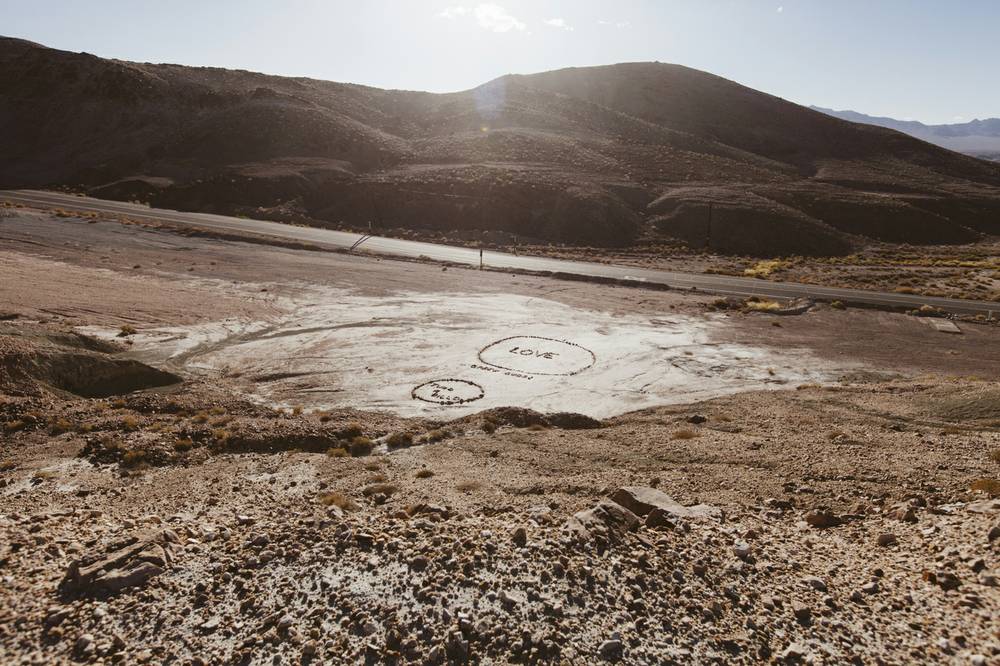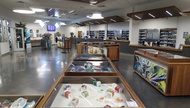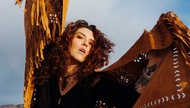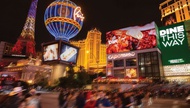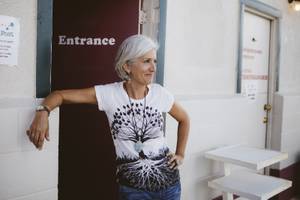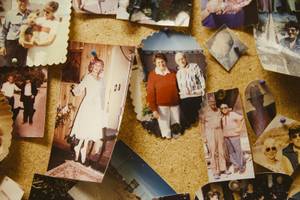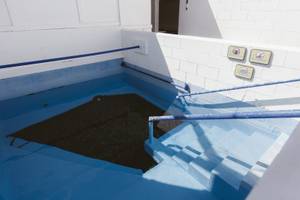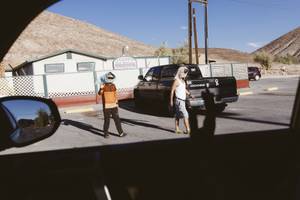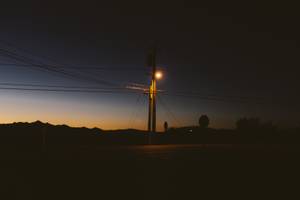Outside the Tecopa Trading Post, a woman watches the sun lower behind the dark slopes of the Ibex Hills and nods hello. “That’s Darby,” she says of the giant lab at her side. “Donna,” she adds, gesturing toward herself.
Darby plops her big body onto the ground. She’s had health problems, and Donna has been soaking her in the artesian runoff in the campground across the road. I rub my hands through her thick fur. “Have you been in yet?” Donna asks. Everyone asks. The geothermal water—seeping from the Earth’s crust, flowing into the private baths of this Southern California campground and string of desert resorts—is why they’re here.
Tour buses arrive throughout the year, mostly unloading Koreans who have flown into LA, then set out for Tecopa to sit in the ancient water. Native Americans used these springs, horse and cattle rustlers, miners. Eventually, the snowbirds will arrive to do the same, retirees soaking their ailments in temperatures just above 100 degrees. You could come here and live on nothing, but have it all, including the Milky Way.
“It’s a high-energy vortex,” says part-time local Paul Carter, a tanned, fit and shirtless 40-something truck driver everyone says can fix anything. “Some people are hard-core world travelers. They can stop anywhere. They choose here. A lot of people don’t know even how they find it.”
He checks Darby’s paws for any signs of heat damage while his own dog Nylah circles the campground’s trading post to investigate, then returns. He calls her “honey.” Cars pass through the slow intersection that connects to the campground spreading over both sides of the road. Like Nylah, some travelers stop in to say hi, then move on. There’s no cell service. No texting. Conversation is abundant, a delicacy afforded those willing to pull into this former mining town, a gateway to Death Valley that for many is the destination itself.
Like other tiny desert towns sitting quietly in the Mojave, Tecopa is noted for its rich history and legendary residents. It was named for Chief Tecopa of the Paiutes, who defended the land from white intruders but eventually sought peace.
For a time it was home to Paul Watkins, the famous member of Charles Manson’s Family who testified against Manson, securing his conviction for the notorious Helter Skelter murders. Watkins founded the Death Valley Chamber of Commerce, and his daughter, writer Claire Vaye Watkins, grew up here, near the Old Spanish Trail.
Brothers William and Robert Brown founded the mining outpost in 1875, originally naming it Brownsville. It’s an area favored by academics and geologists, as the rocks are up to 250 million years old. But really, it’s about the soothing water, the individual freedom and the quiet of the desert.
“You’re in the middle of nowhere, and amazing things happen,” says Amy Noel, who owns the Tecopa Hot Springs Resort next to the campground. She’s talking about a woman in her 80s who rode through town on a horse, inspired by dancer Marta Becket, who moved here from New York more than 40 years ago to open a one-woman show in her Amargosa Opera House, which still stands.
Seniors love it here, but eventually their children decide their parents are too old to continue wintering in such a remote area. There’s no hospital, only modest lodging, a restaurant, art gallery, cemetery, church, library, brewery and post office. Water and groceries are brought in from Pahrump. The nearest gas station is nine miles away in Shoshone, and the school in Tecopa is closed, because there aren’t enough kids in town to keep it open. Students are bused into nearby Shoshone.
It’s rugged—pampering without the velvet ropes. The resorts are humble structures on the open desert, but the population of about 150 jumps to 500 during the season. Snapshots of the snowbirds are tacked to the bulletin boards inside the community center. Shelley Scott, who moved here from Las Vegas, says that the community is big if you consider Shoshone, Tecopa, Amargosa and the China Ranch Date Farm “the suburbs of Death Valley.”
Hula hoops are everywhere. We see one leaning outside a bus-turned-home under a thicket of palm trees near Tecopa’s labyrinth, where the wind on the plateau is knocking me off course as I run through howling because nobody can hear us anyway.
We meet the bus’ tenant that night—an attractive, quiet woman named Izabelle Nuckle—a French-Canadian artist who settled in Tecopa last Christmas, learning of the town from her husband, who used to visit in the ’70s and ’80s. She helps maintain the Tecopa Hot Springs Resort, cleans the pool and works as a massage therapist. Her husband’s in the film industry in LA, and they’re looking to buy a permanent home here.
The resort is run by LA-transplant Noel, who worked for 20 years at the J. Paul Getty Museum and had been visiting Death Valley since the late ’70s. Following a sabbatical in 2000 during which she volunteered at the Shoshone Museum, she dreamed big and bought the property with friends, moving to Tecopa in 2005. She’d already laid down the bones of the labyrinth formed of rocks representing different geological eras, then opened the art gallery to showcase the area’s rich artist population.
At the former gas station now known as the Death Valley Internet Cafe, another gallery has taken form—paintings of American television shows and titles. Dozens, maybe more than 100, dominate the naturally lit dining room. Alex Gjestvang creates them daily. He has autism and came here with his older brother Robert Surdel, a former sous chef at STK at the Cosmopolitan who opened the cafe in May with chef Eric Scott. They’d always wanted to work together, Surdel says of his brother. “It’s Two Chefs and an Artist.”
Surdel knows the family that owns Delight’s Hot Springs Resort, where his restaurant operates, and made this move about 80 miles west and a world away for a change of pace, for the hot springs and to serve all-natural foods picked from local farms. “It’s all about being healthy. That’s what it’s really about,” he says. “I’ve lost 40 pounds out here. But there’s really a sense of community. A lot of friendships are made here, even if they’re not from here.”
The community is international, and fluctuates depending who’s in town. At the campground, Michel Olson and Christy Horne of the Gypsy Time Travelers ride in on motorbikes after a day of exploring. Their famous gypsy rig is parked in Shoshone, but they’re here to say hello to friends outside the trading post. They spend as much as three months a year in the area soaking in the baths, Olson says, adding, “It’s my Ponce de León.”
The pools in the campground’s cement, gender-segregated buildings are open 24 hours. As it is with all of the private baths, nudity is required. Minerals pull the soaps out of clothing, which degrades the water. Everything flows out into the marsh. So no shampoos, no lotion, no hair in the water.
We stroll the grounds with Nancy Good, a well-traveled artist and musician who bought a house in Tecopa Heights more than three years ago with her husband Paul Barnes, and watched the “neglected” campground go downhill. They took over management in January with partner Ryan Thomas and his wife, Lara Murray, and spent four months remodeling, restoring and handling damage control online from years of the previous management. The campground has more than 200 sites, and at the base of the mountain behind the baths, Barnes built a stunning one-room, 11-by-12-foot portable rental cabin with an 8-foot wooden porch. The plan is to build a village of these cabins, and a stage for music.
The quaint trading post sells dry goods and camping supplies, a stock so thorough you can drive in with nothing but yourself and get everything you need to set up camp. There’s even a short-wave radio station that plays Flying Eye podcasts.
This will be the first full season in business for Good and Barnes. Thomas, originally from Maryland, remembers a time in the late ’90s when it wasn’t possible to find a vacancy at the campground, before it went from 100 percent occupancy to just 6 percent. Under their management, they expect it to return to higher capacity, because they understand the culture: “There are people who live and breathe hot springs,” Thomas says. “They just go from hot spring to hot spring.”
Good adds, “We’re stewards of this very special water, and we treat it that way.”
At night we understand why Death Valley is designated an International Dark Sky Park. There’s an added dimension to the stars twinkling in the blackness, and we see so many of them.
With most of the campers retired for the night and the locals talking outside, we slip out of our clothes, rinse off impurities and finally dip into the clear water. It’s silky, salty and 105 degrees. We’re naked under the open sky, soaking in time. Some say it’s just water. Others believe it’s magical.
Baptized by the mystery and the minerals, we feel different. Healthier. Clean. Restored. Not in some supernatural way, but the water is so still. My friend Mikayla feels intoxicated. I feel like doing a million pull-ups on the bar above the pool. I do 10,000.
We don’t want to, but we have to get out. The water is hot. And the touch of it lingers.
